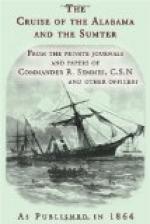Ship under U.S. colours and register. Cargo, white pine lumber, laden on board at the port of New York. The cargo was shipped by Edward F. Davidson, who appears, from the statement of the master, to be a large lumber dealer, and is consigned to Messrs. Zimmerman, Faris, and Co., at Monte Video, or Buenos Ayres. Annexed to the bill of lading is what purports to be an affidavit sworn to before “Pierrepont Edwards,” who signs himself as “vice-consul.” Above his name are the words, “by the consul,” from which it appears he professes to act for the consul, and not for himself as “vice-consul."[14] The affiant is Joseph H. Snyder, who describes himself as of “128, Pearl Street, New York.” He states that the cargo was shipped by Edward F. Davidson, “for and on account of John Fair and Co., of London, &c.” First, as to the form of this affidavit. A vice-consul is one who acts in place of a consul when the latter is absent from his post; and when this is the case, he signs himself as vice-consul, and his acts take effect proprio vigore, and not as the acts of the consul—which this act purports to do. Further, the Master was unable to verify this document, which, to give it validity, he should have been able to do—he declaring that he could not say whether it was a forgery or not. “Although, as has been said, the ship’s papers found on board are proper evidence, yet they are so only when properly verified; for papers by themselves prove nothing, and are a mere dead letter if they are not supported by the oaths of persons in a situation to give them validity.” 3rd Phillimore, 394. Further, “Valin sur l’Ordonnance” says, “Il y a plus, et parceque les pieces en forme trouvees abord, peuvent encore avoir ete concertees en fraude, il a ete ordonne par arret de conseil du 26 Octobre, 1692, que les depositions contraires des gens de l’equipage pris, prevaudrojent a ces pieces.” The latter authority is express to the point, that papers found on board a ship are not to be credited, if contradicted by the oath of any of the crew, and I take it that an inability to verify amounts to the same thing. For if this had been a bona fide transaction, it was the duty of the party interested to take the master before the consul to witness the taking of the deposition, so that he might verify “the paper,” if captured. But why should Mr. Snyder be the party to make this affidavit? He was not the shipper, but Davidson, a lumber dealer; and Davidson, who, if he sold the lumber at all, must have known to whom he sold it, was the proper person to testify to the fact. Further: the master says that Snyder bought the lumber from Davidson, as he was informed by his (the master’s) brother, who was the owner of the ship. If so, then Snyder being the owner of the lumber (whether on his own or foreign account, it matters not) was the real shipper, and not Davidson, and the proper person to consign it to the consignees, either in his own name, or in the name of his principal,




